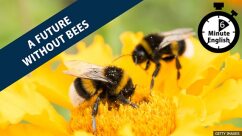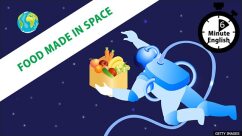Eating Breakfast
COMPLETE TRANSCRIPT
Welcome to English as a Second Language Podcast number 4: Eating Breakfast
This is English as a Second Language Podcast episode number four. I’m your
host, Dr. Jeff McQuillan, coming to you from the Center for Educational
Development in beautiful Los Angeles, California.
In this episode, the third of our 10-part special series on daily English, I’ll talk
about eating breakfast in the morning.
Let’s get started!
[Start of story]
I walk into my kitchen and turn on the coffeemaker. I always put the coffee, filter,
and water in the night before so it’s ready to go. Next, I open the door of the
cupboard where the cereal is stored. I would love to have ham and eggs for
breakfast every morning, or maybe a stack of waffles, but the truth is that I just
don’t have the time to cook.
So, I pour myself a bowl of cereal and put in a glass of skim milk, making sure I
take a spoon out of the silverware tray. I go outside and pick up my newspaper,
and sit down at the kitchen table. I love reading the paper in the morning, though
usually I just have time to read a few of the stories. When I’ve finished my
cereal, I grab a banana and maybe make a slice of toast with jam. I rinse off my
breakfast dishes in the sink and put them in the dishwasher. By that time, my
coffee is ready so I pour myself a cup and put the rest in a Thermos for work.
[End of story]
In this episode, we are eating our breakfast. I begin by walking into my kitchen
and turning on the coffeemaker. Notice these verbs, “to walk into” or “to walk in,”
“to turn on.” Those two-word verbs are very common in English. So, I don't just
walk to my kitchen, “I walk into my kitchen and I turn on the coffeemaker.”
The “coffeemaker,” (coffeemaker) – all one word – is the machine that, you can
guess, makes the coffee; that's the coffeemaker. Usually, a coffeemaker has
water on the top—place where you put the water—and then, it has a place for the
actual coffee. Now, you take the coffee and you put it into a piece of paper or a
Posting of piece of plastic called a filter. The “filter” (filter) is something that allows the
water to go through it, but doesn't allow the coffee to go through it.
So, you put the coffee into the filter and the hot water goes through the coffee, it
goes out of the filter and goes into the “coffee pot” (pot) the coffee pot is on the
bottom. So, you have the coffee, the coffee filter, and the coffee pot. After the
water goes through the coffee, what you have to throw out—what you have to
remove when you are done—are called the “coffee grounds” (grounds)
Well, “I put in the coffee, the filter, and the water the night before,” meaning, in
this case, last night, “so that it is ready to go,” meaning when I walk into the
kitchen, it is already ready, I just have to turn it on. Some coffeemakers have
clocks that will automatically turn your coffeemaker on in the morning.
“Next, I open the door of the cupboard where the cereal is stored.” The
“cupboard” – cupboard – which looks like the word “cup” and the word “board”
put together, but is pronounced cupboard — a cupboard is like a cabinet. It's a
place where you store things — a place where you keep things. “To store”
(store) – as a verb, means to keep something in a place — to keep something in
a cupboard, or cabinet, or a box. Well, the cupboard is what we call the cabinets
that are in the kitchen. They're the like wooden boxes that have doors on them
that you can put things in. Usually, if it's a big cupboard, you have different
“shelves” (shelves) the singular is “shelf” (shelf).
Well, I go into the cupboard and I get the cereal out. The “cereal” (cereal) is a
very popular breakfast in the United States. It's usually dry and you put milk in a
bowl, with the cereal, and eat the cereal and the milk together. I love cereal in
the morning. I really do; I have cereal every morning. Since I was, I think, five
years old, I've been eating cereal.
I take the cereal out — where it is stored in the cupboard — and I prepare my
breakfast. I say in the story that “I would love to have ham and eggs for
breakfast every morning.” “Ham” is a type of meat that comes from a pig; it
usually has a lot of salt in it. Another kind of meat that's popular in the morning
for breakfast is “bacon” (bacon) which is also meat that comes from a pig. It is
long and thin usually; it's cut to be long and thin. Eggs are the things that come
from chickens — or does the chicken come from the egg? I'm not sure.
Anyway, we have ham and eggs, which is a very popular American breakfast.
Many people in the United States eat what we would call a very heavy breakfast,
meaning there's lots of fat and there's lots of food. In some countries, this is not
done, but in the United States it's very common for people to have eggs and ham
for breakfast. My father used to have eggs every morning for breakfast before he
went to work.
Well, I say, “I would love to have ham and eggs for breakfast every morning, or
maybe a stack of waffles.” A “waffle” (waffle) is something that is made from
batter. “Batter” (batter) when we talk about cooking is a liquid, made usually with
eggs, and flower, and perhaps milk, and you combine these things together and
you get a thick liquid, which we call batter, and you take the batter and you put it
into a special cooking machine, which we call a “waffle iron” (iron) And, a waffle
iron has a certain shape, usually it's square, and when you put the batter in, you
close the top of it and you cook it from both sides. And, when you take it out, it
has little squares in it, and this is called a waffle. It's a kind of almost like a
bread. And, after you make the waffle, you usually put some special type of
liquid sugar, which we call “syrup” (syrup). Often, this comes from trees; the best
syrup comes from maple leaf trees. It's called maple syrup; it's very good. And,
you put that thick sugar liquid on top of the waffle. You can also put some sort of
fruit on top of the waffle also; I just like the sugar, myself.
Something similar to a waffle is a “pancake” (pancake) – all one word – and a
pancake is also made from this batter — this liquid — thick liquid — except it
goes into a flat pan on your stove and you flip it over. So, it's completely flat,
there are no squares in it, usually it's round, and that's called a pancake.
Both waffles and pancakes can be in stacks. A “stack” (stack) is when you have
one long, thin thing on top of another. So, you can have a stack of paper, pieces
of paper one on top of the other. The same is true with a waffle or with
pancakes. You can have a stack of waffles, one waffle on top of another, or a
stack of pancakes. Usually, we talk about a stack of pancakes. If you go to a
restaurant and you order breakfast and you want pancakes, sometimes they will
ask you if want a “short stack,” meaning just one or two, or you might have a
regular stack, which could be four or five. Remember, Americans eat a big
breakfast, that's why there's so many big Americans.
Getting back to our story, I am not having ham, eggs or waffles; I'm having a
bowl of cereal. And, to prepare my cereal, I put it into a bowl and I pour skim
milk on top. “Skim (skim) milk” is milk with no or very little fat in it. Milk comes in
four different types: you have whole milk, which has the most fat; you have two
percent milk, which has somewhat less fat; you can have one percent, which is
even less fat; or you can have fat free, or skim, milk, which has little or no fat at
all. Well, because I don't want to be a big American, I have skim milk.
In order to eat my cereal, I have to take a spoon out of the silverware tray. The
“silverware” (silverware) – all one word – is the name we give the knife, the fork,
and the spoon together. Sometimes those are called silverware even though
they are not made of silver. Other people in a restaurant may call them utensils.
“Utensils” (utensils). If you go to a restaurant and you sit down and you don't
have a spoon or a fork or a knife, you would ask the waiter or waitress for some
utensils, or you could just say, “I need some silverware.”
A “silverware tray” (tray) is a place where you put the silverware — you put the
utensils, the forks, the spoons, the knives — in a drawer. And, usually a tray is
like a little box that has holes in it for specific things. That word, tray, can also be
used to describe a small, flat piece of plastic or wood that you use to carry things
on, like your dishes.
Well, I get my spoon, and I go out and I get my newspaper, which, of course, is
what has the news, the sports, and the international and national news. Many
Americans like to read a newspaper in the morning, just like people all over the
world do. “I “sit down at the kitchen table and I read the paper.” Sometimes we
call a newspaper just the paper. Someone says, “I read it in the paper this
morning,” they mean the newspaper.
Usually I just have time to read a couple of stories, a few of the stories. When
I’ve finished my cereal, I grab a banana and maybe make a slice of toast with
jam.” “To grab” (grab) means to take something, usually with your hand. “To
grab something with your hand” means to pick it up — to take it with your hand.
“I grab a banana,” which I like to eat, and “a slice of toast with jam.”
“Toast” (toast) is bread that you put in something called a “toaster” (toaster) and
the toaster heats up the bread until the bread is brown on the outside. “A slice of
toast” (slice) is a piece of toast. We use the words slice when we are talking
about one piece of bread, or one piece of cake. You can have a slice of cake;
you can also have a slice of pie.
This is a slice of toast, which is bread that we put in a toaster, and we toast the
bread. We can use toast as a verb as well. And, after I toast the bread, I can put
butter on it or I can put “jam” (jam). And, jam is made from fruit — such as
strawberries — and sugar, and they put them together and it makes a thick liquid
that you can put on a piece of toast. We would say we spread the jam on the
toast. We use that verb “spread” (spread) to talk about putting butter or putting
jam on a piece of toast, usually with a knife.
When I am done with my breakfast, “I rinse off my breakfast dishes.” “To rinse”
means to clean something with water. To rinse off is the verb. You could just
say, “I rinse my breakfast dishes,” but we like those two-word verbs in English
and so we would probably say, “rinse off my breakfast dishes.”
I rinse them off in the sink, and I put them in the dishwasher. The “dishwasher”
(dishwasher) is a machine that cleans the dishes. Some families have
dishwashers. The joke that we make sometimes in English is that someone —
when someone says, “Oh, do you have a dishwasher?” and you say, “Yes, I am
the dishwasher,” which means you don't have a machine that washes your
dishes; you wash your dishes by yourself. We would say you wash them by
hand.
But the time I'm finished rinsing off my breakfast dishes, my coffee is ready and
so, I pour myself a cup. Notice the use of that verb, “pour.” We use that verb
when we are removing liquid from a bottle and putting it into a cup or a glass.
We also used that verb, “pour,” when I said, “I pour myself a bowl of cereal.”
Now, cereal isn't liquid, but it is something that you can put into another
container, in this case, into a bowl, and it comes out of the bigger container and
into the smaller container. So, it comes out of the cereal box and goes into the
bowl. So, we use that verb usually when we talk about liquid things like water or
milk, but you can also use it when we talk about cereal.
Well, “I pour myself a cup” of coffee and I “put the rest in a Thermos for work.” A
Thermos, which is “Thermos,” is a bottle that keeps hot liquid hot and cold liquid
cold. So, if you have hot coffee and you put it into a Thermos, the Thermos—this
bottle—will keep it hot for a long time.
Now let's listen to the story, this time at a regular speed.
[Start of story]
I walk into my kitchen and turn on the coffeemaker. I always put the coffee, filter,
and water in the night before so it’s ready to go. Next, I open the door of the
cupboard where the cereal is stored. I would love to have ham and eggs for
breakfast every morning, or maybe a stack of waffles, but the truth is that I just
don’t have the time to cook.
So, I pour myself a bowl of cereal and put in a glass of skim milk, making sure I
take a spoon out of the silverware tray. I go outside and pick up my newspaper,
and sit down at the kitchen table. I love reading the paper in the morning, though
usually I just have time to read a few of the stories. When I’ve finished my
cereal, I grab a banana and maybe make a slice of toast with jam. I rinse off my
breakfast dishes in the sink and put them in the dishwasher. By that time, my
coffee is ready so I pour myself a cup and put the rest in a Thermos for work.
[End of story]
You’ll want to grab a copy of anything written by our scriptwriter, Dr. Lucy Tse. It
is sure to help you with your English.
From Los Angeles, California, I’m Jeff McQuillan, thank you for listening.
and Jessica Brown.
GLOSSARY
coffeemaker – a machine that makes coffee by passing hot water through
ground coffee beans
* Scott has a very small coffeemaker that makes only two cups of coffee each
time.
filter – a thin piece of paper that allows liquid to pass though, but prevents the
ground coffee beans from getting through
* This morning, his cup of coffee had a lot of small pieces of coffee beans in it
because he forgot to put the filter in his coffeemaker.
the night before – the previous night; yesterday night
* I always choose my clothes the night before, so that I can get dressed more
quickly the next morning.
cupboard – a wooden box with shelves and a door that hangs on a kitchen wall
and is used to store plates, glasses, and other things
* Please dry the plates and put them back in the kitchen cupboard above the
stove.
cereal – a food made from grains (wheat, oats, barley) that is eaten with cold
milk for breakfast
* I’ve never known anyone who liked to eat cereal as much as he does. He eats
it for breakfast and dinner!
to store – to keep; to put something in a place to use later
* Where should we store these bicycles? Do you have room in the garage?
ham and eggs – a traditional American breakfast of fried, salted pork and eggs
* I’m like to order some toast to go with my ham and eggs.
stack – a pile of objects resting on each other that goes up
* When her boyfriend saw that she was carrying a huge stack of books to her
class, he offered to help her.
waffle – a square piece of thick, sweet bread with small square shapes on each
side, usually eaten for breakfast with syrup, honey, or jam
* To make waffles, you will need flour, sugar, salt, eggs, and milk.
skim milk – milk that has no fat
* She asked her assistant to get her a cup of coffee with a little skim milk and no
sugar.
silverware tray – a container that holds forks, knives, and spoons
* Once the forks are dry, please put them in the silverware tray.
newspaper – large pieces of paper printed with news and advertisements,
usually produced daily or weekly
* We get the Sunday newspaper delivered to our house so we don’t need to go to
the store to buy it.
to grab – to quickly take something with one’s hand
* He grabbed the child’s hand and pulled her away from the busy street.
slice of toast with jam – a crispy, heated piece of bread covered with sweet,
mashed fruit
* I usually have a slice of toast with jam for breakfast, but today I didn’t have
time.
to rinse off – to use water to remove dirt or small pieces of food from an object
* She didn’t have time to wash the dishes this morning, but she rinsed them off
so that it wouldn’t be too difficult to wash later.
dishwasher – a machine that washes dishes
* The dishwasher broke right before the party and we had to wash all of the
dishes by hand.
thermos – a container that has a tight lid that keeps liquids warm or cold
* He always carries two thermoses to work, one for his coffee and the other one
for his soup.









